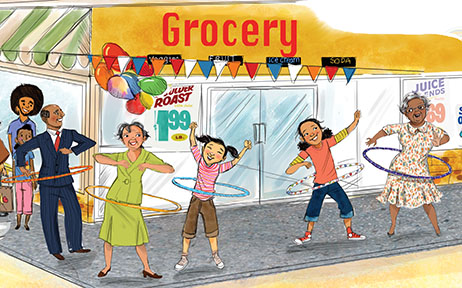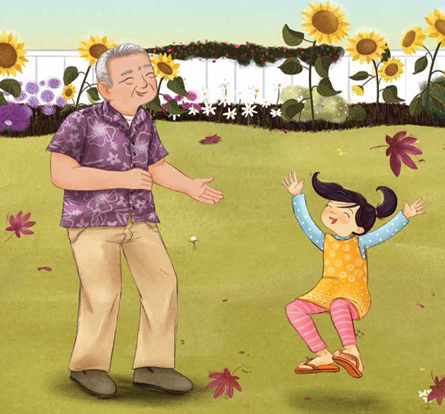 Today we are pleased to share this guest post from L
Today we are pleased to share this guest post from L![]() ibrarian and Diversity Coordinator Laura Reiko Simeon on ageism in children’s literature. Welcome, Laura!
ibrarian and Diversity Coordinator Laura Reiko Simeon on ageism in children’s literature. Welcome, Laura!
Super Grandpa by David M. Schwartz was inspired by the true story of Gustaf Håkansson, who in 1951 at age 66 won a 1000-mile bike race in Sweden after being banned from entry on the grounds that he was too old. Before reading this inspiring tale to my elementary-aged students, I asked them to say the first words that came to mind when they heard the word “grandpa.” Some of them were positive to be sure (kind, gentle, loving, cheerful), but most were far less so: slow, bent, broken down, tired, sleepy, weak, cane, and, ahem, smelly! Of course, they cheered for Super Grandpa and were deeply indignant that he wasn’t even officially allowed to try to race (given how often children are forbidden from doing things on the basis of age, I suspect the injustice of this resonated on a personal level)!
However, I couldn’t stop thinking about their initial responses to the word “grandpa.” As I began to pay closer attention, I noticed that a significant number of picture books about older people seemed intended to help children come to terms with their grandparents’ death or mental deterioration. I also observed that older people were often shown as lonely, objects of pity, or cantankerous and vaguely alarming. The AGHE Book Award for Best Children’s Literature on Aging encourages “positive portrayals of older adults in children’s literature” to help counteract this, but is unfortunately not yet very well known.
Surveys of children’s literature confirm my impressionistic observations, but also offer reason for hope. Edward Ansello’s groundbreaking 1977 study found that the three adjectives most frequently used to describe old people in children’s literature of the time were “old,” “sad” and “poor.” In J.B. Hurst’s 1981 survey, older adults were referred to as “nice” or “wise” in three of the books sampled, but in the remainder were described as “funny, small, little, grumpy, lonely, poor, and weak.” In a 1993 study, Sandra McGuire wrote that, “The literature is almost void of older people; frequently fails to fully develop older characters; often focuses on illness, disability and death; and gives children little to look forward to as they age.” Jessica L. Danowski‘s survey of picture books published between 2000-2010 found that the elderly were disproportionately portrayed as white (77%) and male (60%), and that they comprised only 5.6% of all characters. On the bright side, however, the portrayals overall were positive in nature, and most frequently showed older adults who were physically active.
As increasing numbers of people live healthy, vibrant, active lives ever later in life, we need more of these types of picture books that reflect the true gamut of roles older adults play in our society. Given the reverence and respect shown to elders in many cultures, diverse literature is a natural place to look to fill this need.
An immigrant grandmother turns innovator in Frances and Ginger Park’s The Have a Good Day Cafe. Tired of her family’s leaving her at home while they go out to run their hot dog stand, Grandma declares, “I did not travel ten thousand miles just to stay home and rest my feet day after day.” Observing that the stand is suffering from competition from other vendors, she and her grandson come up with a plan to differentiate themselves by selling her Korean specialties, leading to an upsurge in business. This is an enterprising woman who isn’t about to let the grass grow under her feet!
You’re never too old to be a hula-hooping champion, or so proves Miz Adeline in Thelma Lynne Godin’s The Hula-Hoopin’ Queen, set in a gloriously diverse New York City neighborhood. After Kameeka gets distracted while running an errand, her mother is unable to make a birthday cake for their beloved elderly neighbor.
Far from being a pitiful recluse or a crotchety old scold, Miz Adeline is popular and high-spirited. Her friend and hula-hooping rival Miss Evelyn is no slouch either, and the two older women breathe life into the party! Godin handles this skillfully, making hula hooping something that forges a bond across generations rather than turning Miz Adeline into a “bizarre and comical” old person, another common stereotype.
In A Morning with Grandpa by Sylvia Liu, Mei Mei learns tai chi from her grandfather, Gong Gong, and in turn teaches him some yoga. The ebullient little girl struggles to achieve the fluid, deliberate grace of tai chi, while the older man has a bit of trouble with some of the more challenging asanas. Together they have a ball, laughing and encouraging one another, each doing their best while trying something new. It is a charming portrayal of a playful, loving intergenerational relationship.
In Holly Thompson’s touching The Wakame Gatherers, biracial Nanami heads out into the surf collecting seaweed with Gram, her white American grandmother visiting from Maine, and Baachan, who is part of her multigenerational household in Japan. Neither woman speaks the other’s language, but they are bound together by their love for their granddaughter and a spirit of open-mindedness. In this lovely story, two women who lived through a world war that pitted their countries against one another now embrace new cultural experiences, from trying new food to embarking on trans-Pacific travel.
Books that help children come to terms with the loss and bereavement, as well as distressing medical conditions, are certainly necessary—but these tragedies can afflict the young and middle aged as well the old. Greater diversity in picture book portrayals of the elderly benefit readers of all ages.
 The daughter of an anthropologist, Laura Reiko Simeon’s passion for diversity-related topics stems from her childhood spent living all over the US and the world. An alumna of the United World Colleges, international high schools dedicated to fostering cross-cultural understanding, Laura has an MA in History from the University of British Columbia, and a Master of Library and Information Science from the University of Washington. She lives near Seattle where she is the Diversity Coordinator and Library Learning Commons Director at Open Window School.
The daughter of an anthropologist, Laura Reiko Simeon’s passion for diversity-related topics stems from her childhood spent living all over the US and the world. An alumna of the United World Colleges, international high schools dedicated to fostering cross-cultural understanding, Laura has an MA in History from the University of British Columbia, and a Master of Library and Information Science from the University of Washington. She lives near Seattle where she is the Diversity Coordinator and Library Learning Commons Director at Open Window School.










